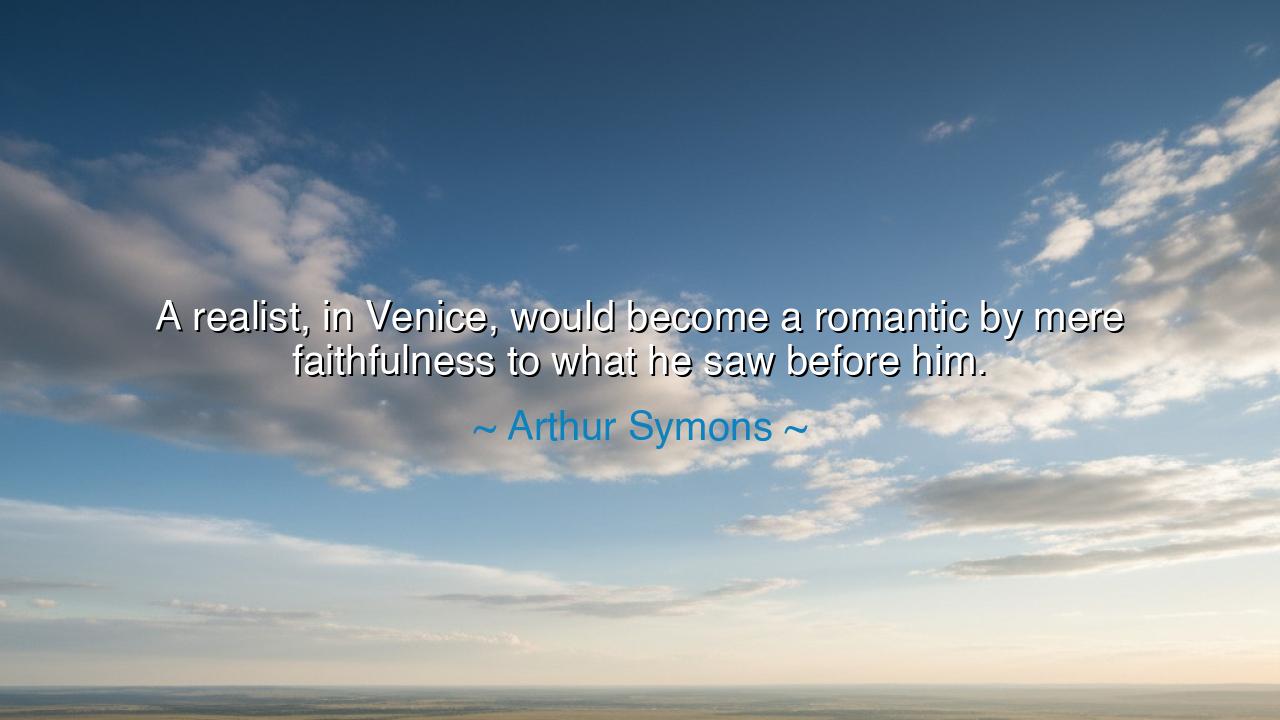
A realist, in Venice, would become a romantic by mere
A realist, in Venice, would become a romantic by mere faithfulness to what he saw before him.






“A realist, in Venice, would become a romantic by mere faithfulness to what he saw before him.” So wrote Arthur Symons, and in this single line he revealed a paradox as timeless as beauty itself. For Venice is not merely a city of stone and water—it is a vision that overwhelms the senses, a place where reality itself glitters with the sheen of dream. To gaze upon its canals, its palaces mirrored in still lagoons, its light trembling on the surface of the Adriatic, is to understand that even the most sober of eyes cannot remain untouched. The realist, sworn to truth, becomes a romantic simply by recording what is there.
Venice has long been the crucible where fact and dream dissolve into one. Born from the sea, raised on wooden piles, it defied nature and empire alike to rise as a jewel of trade, art, and mystery. Its beauty was not invented—it was built, stone by stone, by those who sought survival, commerce, and power. Yet what they created surpassed practicality and became poetry. This is Symons’s revelation: that in certain places, truth itself is more wondrous than fantasy. To describe Venice as it is, without exaggeration, is already to sound like a poet.
History confirms this truth. Lord Byron, wandering Venice in exile, wrote not with restraint but with intoxication, confessing that the city itself seemed alive, its bridges and waters whispering secrets of passion and decay. Even Turner, the painter devoted to light, could not resist Venice’s spell, filling canvases with colors that seemed too radiant for reality—yet they were true to what he saw. Venice seduces even the realist, bending honesty into romance.
And why is this so? Because beauty, when it reaches its height, cannot be contained in sober measure. The romantic spirit is born not only of imagination, but of surrender to overwhelming truth. Venice, with its sinking foundations and shimmering light, teaches us that reality itself can be stranger, more beautiful, and more intoxicating than any dream. The realist may come armed with discipline, but in Venice he finds that discipline itself becomes rapture.
Symons’s insight also speaks to life beyond the lagoon. It reminds us that at times, our insistence on realism blinds us to the wonder before our very eyes. We measure, we calculate, we name—but when beauty overwhelms, even honesty feels like poetry. To witness a sunrise over the desert, to stand before a cathedral, to look into the eyes of one we love—these moments transform realists into romantics, for the truth itself is more miraculous than the imagination we carry.
The lesson here is radiant: do not fear to be called a romantic when reality itself demands it. When life shows you beauty, record it with faithfulness, for in doing so you will find poetry without seeking it. To insist on cold detachment in the face of wonder is to lie; to allow awe to color your words is to honor truth. Venice is but a symbol of this eternal truth—that some realities are too beautiful to be seen without trembling.
Therefore, beloved listener, live with eyes wide open. Seek beauty not by inventing it, but by being faithful to what is already before you. Let your realism lead you to romance when life’s majesty demands it. And remember Symons’s wisdom: in places of great wonder—whether in Venice, or in love, or in fleeting moments of the soul—truth itself is romantic, and to deny it is to deny the very essence of life.






AAdministratorAdministrator
Welcome, honored guests. Please leave a comment, we will respond soon